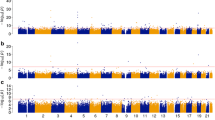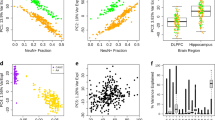Abstract
Schizophrenia is a heterogeneous psychiatric disorder broadly accepted being caused by genetic and environmental factors. Although conventional genetic studies have identified some candidate genes for schizophrenia, low odds ratios and penetrance, and a lack of reproducibility have limited their explanatory power. Despite the major efforts made toward identifying environmental factors in schizophrenia, methodological limitations and inconsistent findings of epidemiological reports have obstructed attempts to identify exogenous causal factors. Epigenetic mechanisms, mediating between environment and genes, have recently been proposed to play an important role in the pathogenesis of schizophrenia. DNA methylation is the most stable and well-characterized epigenetic modification. In this paper, we briefly introduce DNA methylation mechanisms, genome-wide DNA methylation studies, and identify specific genomic methylation sites in individuals diagnosed with schizophrenia. The outline candidate genes such as Reelin and COMT, are also outlined before paying attention to the conundrum of recent researches.

Similar content being viewed by others
References
McGrath J, Saha S, Chant D et al (2008) Schizophrenia: a concise overview of incidence, prevalence, and mortality. Epidemiol Rev 30:67–76
Ng MY, Levinson DF, Faraone SV et al (2009) Meta-analysis of 32 genome-wide linkage studies of schizophrenia. Mol Psychiatry 14:774–785
Cardno AG, Gottesman II (2000) Twin studies of schizophrenia: from bow-and-arrow concordances to star wars mx and functional genomics. Am J Med Genet 97:12–17
Dempster EL, Pidsley R, Schalkwyk LC et al (2011) Disease-associated epigenetic changes in monozygotic twins discordant for schizophrenia and bipolar disorder. Hum Mol Genet 20:4786–4796
Brown AS (2011) The environment and susceptibility to schizophrenia. Prog Neurobiol 93:23–58
Rutten BP, Mill J (2009) Epigenetic mediation of environmental influences in major psychotic disorders. Schizophr Bull 35:1045–1056
Klose RJ, Bird AP (2006) Genomic DNA methylation: the mark and its mediators. Trends Biochem Sci 31:89–97
Ooi SK, Qiu C, Bernstein E et al (2007) DNMT3L connects unmethylated lysine 4 of histone H3 to de novo methylation of DNA. Nature 448:714–717
Chedin F, Lieber MR, Hsieh CL (2002) The DNA methyltransferase-like protein DNMT3L stimulates de novo methylation by DNMT3a. Proc Natl Acad Sci USA 99:16916–16921
Tang HL, Zhu JH (2007) Epigenetics and neural stem cell commitment. Neurosci Bull 23:241–248
Pidsley R, Mill J (2011) Epigenetic studies of psychosis: current findings, methodological approaches, and implications for postmortem research. Biol Psychiatry 69:146–156
Bibikova M, Barnes B, Tsan C et al (2011) High density DNA methylation array with single cpg site resolution. Genomics 98:288–295
Sandoval J, Heyn H, Moran S et al (2011) Validation of a DNA methylation microarray for 450,000 cpg sites in the human genome. Epigenetics 6:692–702
Levenson JM, Roth TL, Lubin FD et al (2006) Evidence that DNA (cytosine-5) methyltransferase regulates synaptic plasticity in the hippocampus. J Biol Chem 281:15763–15773
Sui L, Wang Y, Ju LH et al (2012) Epigenetic regulation of reelin and brain-derived neurotrophic factor genes in long-term potentiation in rat medial prefrontal cortex. Neurobiol Learn Mem 97:425–440
Razin A, Shemer R (1995) DNA methylation in early development. Hum Mol Genet 4(Suppl 1):1751–1755
Petronis A, Gottesman II, Kan P et al (2003) Monozygotic twins exhibit numerous epigenetic differences: clues to twin discordance? Schizophr Bull 29:169–178
Richards EJ (2006) Inherited epigenetic variation—revisiting soft inheritance. Nat Rev Genet 7:395–401
Shimabukuro M, Sasaki T, Imamura A et al (2007) Global hypomethylation of peripheral leukocyte DNA in male patients with schizophrenia: a potential link between epigenetics and schizophrenia. J Psychiatr Res 41:1042–1046
Melas PA, Rogdaki M, Osby U et al (2012) Epigenetic aberrations in leukocytes of patients with schizophrenia: association of global DNA methylation with antipsychotic drug treatment and disease onset. FASEB J 26:2712–2718
Nishioka M, Bundo M, Koike S et al (2013) Comprehensive DNA methylation analysis of peripheral blood cells derived from patients with first-episode schizophrenia. J Hum Genet 58:91–97
Kinoshita M, Numata S, Tajima A et al (2013) DNA methylation signatures of peripheral leukocytes in schizophrenia. Neuromol Med 15:95–101
Kinoshita M, Numata S, Tajima A et al (2013) Plasma total homocysteine is associated with DNA methylation in patients with schizophrenia. Epigenetics 8:584–590
Liu J, Chen J, Ehrlich S et al (2014) Methylation patterns in whole blood correlate with symptoms in schizophrenia patients. Schizophr Bull 40:769–776
Bonsch D, Wunschel M, Lenz B et al (2012) Methylation matters? Decreased methylation status of genomic DNA in the blood of schizophrenic twins. Psychiatry Res 198:533–537
Dempster EL, Mill J, Craig IW et al (2006) The quantification of COMT mRNA in post mortem cerebellum tissue: diagnosis, genotype, methylation and expression. BMC Med Genet 7:10
Aberg KA, McClay JL, Nerella S et al (2014) Methylome-wide association study of schizophrenia: identifying blood biomarker signatures of environmental insults. JAMA Psychiatry 71:255–264
Bromberg A, Levine J, Nemetz B et al (2008) No association between global leukocyte DNA methylation and homocysteine levels in schizophrenia patients. Schizophr Res 101:50–57
Xiao Y, Camarillo C, Ping Y et al (2014) The DNA methylome and transcriptome of different brain regions in schizophrenia and bipolar disorder. PLoS One 9:e95875
Wockner LF, Noble EP, Lawford BR et al (2014) Genome-wide DNA methylation analysis of human brain tissue from schizophrenia patients. Transl psychiatry 4:e339
Mill J, Tang T, Kaminsky Z et al (2008) Epigenomic profiling reveals DNA-methylation changes associated with major psychosis. Am J Hum Genet 82:696–711
Nishikawa S, Goto S, Yamada K et al (2003) Lack of reelin causes malpositioning of nigral dopaminergic neurons: evidence from comparison of normal and Reln(rl) mutant mice. J Comp Neurol 461:166–173
Abdolmaleky HM, Cheng KH, Russo A et al (2005) Hypermethylation of the reelin (RELN) promoter in the brain of schizophrenic patients: a preliminary report. Am J Med Genet B Neuropsychiatr Genet 134B:60–66
Grayson DR, Jia X, Chen Y et al (2005) Reelin promoter hypermethylation in schizophrenia. Proc Natl Acad Sci USA 102:9341–9346
Tamura Y, Kunugi H, Ohashi J et al (2007) Epigenetic aberration of the human REELIN gene in psychiatric disorders. Mol Psychiatry 12:593–600
Tochigi M, Iwamoto K, Bundo M et al (2008) Methylation status of the REELIN promoter region in the brain of schizophrenic patients. Biol Psychiatry 63:530–533
Alelu-Paz R, Gonzalez-Corpas A, Ashour N et al (2014) DNA methylation pattern of gene promoters of major neurotransmitter systems in older patients with schizophrenia with severe and mild cognitive impairment. Int J Geriatr Psychiatry. doi:10.1002/gps.4182
Lott SA, Burghardt PR, Burghardt KJ et al (2013) The influence of metabolic syndrome, physical activity and genotype on catechol-O-methyl transferase promoter-region methylation in schizophrenia. Pharmacogenomics J 13:264–271
Murphy BC, O’Reilly RL, Singh SM (2005) Site-specific cytosine methylation in S-COMT promoter in 31 brain regions with implications for studies involving schizophrenia. Am J Med Genet B Neuropsychiatr Genet 133B:37–42
Abdolmaleky HM, Cheng KH, Faraone SV et al (2006) Hypomethylation of MB-COMT promoter is a major risk factor for schizophrenia and bipolar disorder. Hum Mol Genet 15:3132–3145
Nohesara S, Ghadirivasfi M, Mostafavi S et al (2011) DNA hypomethylation of MB-COMT promoter in the DNA derived from saliva in schizophrenia and bipolar disorder. J Psychiatr Res 45:1432–1438
Zhang AP, Yu J, Liu JX et al (2007) The DNA methylation profile within the 5′-regulatory region of DRD2 in discordant sib pairs with schizophrenia. Schizophr Res 90:97–103
Ikegame T, Bundo M, Sunaga F et al (2013) DNA methylation analysis of BDNF gene promoters in peripheral blood cells of schizophrenia patients. Neurosci Res 77:208–214
Burghardt KJ, Pilsner JR, Bly MJ et al (2012) DNA methylation in schizophrenia subjects: gender and MTHFR 677C/T genotype differences. Epigenomics 4:261–268
Carrard A, Salzmann A, Malafosse A et al (2011) Increased DNA methylation status of the serotonin receptor 5HTR1A gene promoter in schizophrenia and bipolar disorder. J Affect Disord 132:450–453
Xu H, Wang B, Su D et al (2012) The DNA methylation profile of PLA2G4C gene promoter in schizophrenia. Psychiatry Res 200:1079–1081
Naserbakht M, Ahmadkhaniha HR, Mokri B et al (2011) Advanced paternal age is a risk factor for schizophrenia in iranians. Ann Gen Psychiatry 10:15
Haidemenos A, Kontis D, Gazi A et al (2007) Plasma homocysteine, folate and B12 in chronic schizophrenia. Prog Neuropsychopharmacol Biol Psychiatry 31:1289–1296
Petronijevic ND, Radonjic NV, Ivkovic MD et al (2008) Plasma homocysteine levels in young male patients in the exacerbation and remission phase of schizophrenia. Prog Neuropsychopharmacol Biol Psychiatry 32:1921–1926
Wahlberg KE, Wynne LC, Hakko H et al (2004) Interaction of genetic risk and adoptive parent communication deviance: longitudinal prediction of adoptee psychiatric disorders. Psychol Med 34:1531–1541
McGowan PO, Sasaki A, D’Alessio AC et al (2009) Epigenetic regulation of the glucocorticoid receptor in human brain associates with childhood abuse. Nat Neurosci 12:342–348
Guidotti A, Dong E, Gavin DP et al (2013) DNA methylation/demethylation network expression in psychotic patients with a history of alcohol abuse. Alcohol Clin Exp Res 37:417–424
Davies MN, Volta M, Pidsley R et al (2012) Functional annotation of the human brain methylome identifies tissue-specific epigenetic variation across brain and blood. Genome Biol 13:R43
Ruzicka WB, Zhubi A, Veldic M et al (2007) Selective epigenetic alteration of layer I gabaergic neurons isolated from prefrontal cortex of schizophrenia patients using laser-assisted microdissection. Mol Psychiatry 12:385–397
Tremolizzo L, Doueiri MS, Dong E et al (2005) Valproate corrects the schizophrenia-like epigenetic behavioral modifications induced by methionine in mice. Biol Psychiatry 57:500–509
Tremolizzo L, Carboni G, Ruzicka WB et al (2002) An epigenetic mouse model for molecular and behavioral neuropathologies related to schizophrenia vulnerability. Proc Natl Acad Sci USA 99:17095–17100
Laird PW (2010) Principles and challenges of genomewide DNA methylation analysis. Nat Rev Genet 11:191–203
Davies MN, Volta M, Pidsley R et al (2012) Functional annotation of the human brain methylome identifies tissue-specific epigenetic variation across brain and blood. Genome Biol 13:R43
Harris RA, Wang T, Coarfa C et al (2010) Comparison of sequencing-based methods to profile DNA methylation and identification of monoallelic epigenetic modifications. Nat Biotechnol 28:1097–1105
Harrison A, Parle-McDermott A (2011) DNA methylation: a timeline of methods and applications. Front Genet 2:74
Acknowledgements
This work was supported by the National Natural Science Foundation of China (81271484 and 81471361 to X.C, 30900486 and 81371480 to J.T) and the National Key Basic Research and Development Program (2012CB517904 to X.C).
Conflict of interest
The authors declare that they have no conflict of interest.
Author information
Authors and Affiliations
Corresponding authors
Electronic supplementary material
Below is the link to the electronic supplementary material.
About this article
Cite this article
Zong, X., Hu, M., Li, Z. et al. DNA methylation in schizophrenia: progress and challenges. Sci. Bull. 60, 149–155 (2015). https://doi.org/10.1007/s11434-014-0690-y
Received:
Accepted:
Published:
Issue Date:
DOI: https://doi.org/10.1007/s11434-014-0690-y




